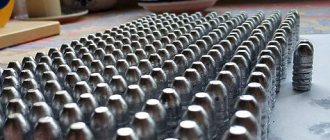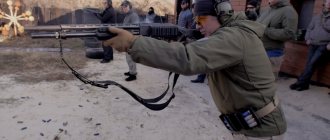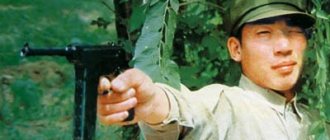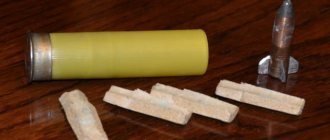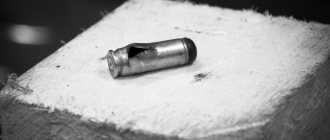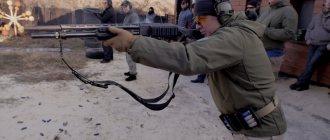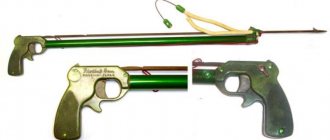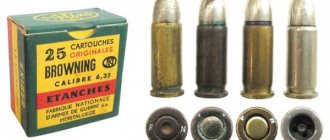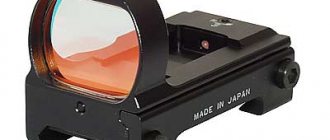Hardening steel in the Middle Ages: from copper to iron
Initially, the metal for making swords and knives was copper. This is a fairly soft metal: it does not hold the shape and sharpness of the blade well. Therefore, copper was soon replaced by a more durable alloy of copper and tin - bronze. But even such weapons were imperfect, and also expensive. Therefore, blacksmiths looked for new solutions.
They learned to process iron later. Why? Firstly, copper and bronze lend themselves well to cold forging, but iron had to be forged in a hot state. Secondly, where to get raw materials? In Japan, for example, the Iron Age began only in the 7th century AD: the earth was poor in metals. In Europe - much earlier. Even before our era, iron ore deposits were found here. Iron was first used to make weapons in Asia in the 12th century BC.
P. Lange believed
P. Lange believed that if steel barrels (we are talking about steels from the early 20th century) can withstand double pressure of 1100 kgf/cm2 with a barrel wall thickness of 2.77 mm 65 mm from the breech cut, then Damascus steel barrels can withstand this pressure in the same place of the barrel with a wall thickness of 3.96 mm. Therefore, at the beginning of the 20th century. hunters who had guns with Damascus barrels of normal weight and with sufficient wall thickness used not only smoke, but also smokeless gunpowder. However, these days this should not be done, even if at one time the gun was shot with smokeless powder. The fact is that in Damascus steel barrels, accelerated corrosion occurs along the welding points of the rods and strips, which leads to the formation of microcracks that reduce the strength of the barrels. It is therefore impossible to say with certainty whether certain Damascus barrels will withstand firing even with standard cartridges loaded with smokeless powder, not to mention cartridges with reinforced charges. Stainless steels for the manufacture of gun barrels (“Anticorro”, “Antinit”) began to be used in 1910-1912.
How swords were made from iron
What is steel? It is an alloy of iron and carbon. Thanks to the latter, it can be hardened.
Sword steel is forged at temperatures from 850°C to 1300°C. But if now production allows you to automatically control the temperature and maintain the hardening time, then how did they cope with this in ancient times to forge swords? Believe it or not, the temperature was determined by eye - by the color of the glow of the metal.
For example, a cherry tint means that the melting point of steel reaches 800°C, dark yellow - over 1000°C, dazzling white - over 1250°C.
The craftsmen also monitored the tempering temperature of the metal. It also has its own nuances and color gradation. The composition of weapons steel was different at different times.
Later, various additives began to be added to steel for the manufacture of sabers and swords - chromium, molybdenum, vanadium, cobalt, tungsten, nickel... They improve the properties of the finished material and the texture of weapon steel, and the products become more durable and hard.
Chromium makes steel resistant to corrosion, molybdenum prevents brittleness, tungsten increases hardness, vanadium increases strength, and cobalt improves cutting properties. The main task in the manufacture of an alloy is to find the optimal combination of elements. This knowledge is available to us today, and blacksmiths achieved the smelting of ideal weapons by trial and error.
They monitored how the steel reacted to changes in temperature during the forging of the blade. If you heat it up and cool it slowly, the metal will turn out soft. Cool quickly by immersing in cold water - it will acquire unprecedented hardness. If you don't heat it enough, it will break. Difficult? Still would!
Rifled barrels are made in three ways
The first is pulling the broach while turning the cutting tool, as a result of which it acquires a helical motion and makes rifling in the barrel bore with a certain pitch and depth. The second method is pulling without removing chips by pressing a profiled mandrel, shaped like the required rifling, through the barrel bore. The third method is cold forging a rifled barrel. The forging mandrel has the shape of a rifled barrel channel. The barrel blank is put on a mandrel and forged with a hammer. In this case, the mandrel rotates in accordance with the pitch of the rifling. A barrel made in this way has higher strength and accuracy than barrels made by the two previous methods.
Damascus and damask steel: history of blade manufacturing
Surely you have heard about Damascus steel and damask swords. Legends have been made about this weapon for centuries, and the technology of forging the blade was kept secret. But the question is different. How did the first metallurgists, without modern knowledge, come up with the idea of combining layers of soft and hard steel together to make these blades? What did you get? It’s like a “sandwich” – a multi-layered piece. The metal for the knives was forged, folded, forged again, and these actions were repeated until the number of layers of metal reached one thousand, or even more. As a result, the weapon became hard and elastic at the same time. Next, the metal for the blades was polished, and stains characteristic of Damascus steel appeared on it - the result of multi-layering. Beautiful? Very.
Bulat was produced differently - high-carbon steel was used as a basis. It was practically cast iron, which retained the ability to forge. When melted, particles of low-carbon metal were added to it, which, when cooled, gave the weapon excellent cutting properties.
Corrosion of barrel metals
Metal corrosion is destruction due to interaction with the external environment containing oxygen, carbon dioxide, and water. As a result of this, what hunters call a “rash” first appears in the bore, then larger spots of rust, in place of which shells form over time. The size and depth of the shells can increase so much that they weaken the barrel, making it unfit for shooting. Rusting has a particularly severe effect on rifled barrels, in which the appearance of any shells is unacceptable, as this reduces the quality of the gun’s action. In smooth barrels, shallow shells do not impair the quality of the action and do not pose a danger to the gun. To extend the service life of hunting rifles, chrome plating of barrel bores has been introduced into the production cycle in recent decades. In addition to protecting the barrel metal from erosion and corrosion, the chrome coating, having high hardness, reduces the wear rate of the inner surface of the barrel.
Weapon Steel: Present Days
For thousands of years, the world has been producing weapons from metal: swords, blades, knives... Technologies have improved, and now metallurgists have already come to the so-called powder high-carbon alloy steel. This steel is mainly used for the manufacture of army, fishing or hunting knives. They are in demand because they are extremely sharp and hold an edge well. The advantage of this technology is that metal for weapons is easy to process, and there is no waste left: the remains can always be processed into powder and the cycle can be resumed.
By the way, all modern metallurgy strives for zero waste. And also – to the cleanliness of production. So, there is no magical power in a weapon, rather the opposite... Its power is deadly, but a sword, blade or knife cannot be considered solely in this context. The evolution of weapons is inextricably linked with progress in metallurgy. Where did you start? From ductile copper, from which, thanks to one forging, thin and sharp blades were obtained. What did you come to? To chemical elements as additives... to powder steel, and also to optimization and automation of production. What will happen next? Believe me, metallurgists will be able to surprise us. And the question is not speed, but direction.
Aluminum vs steel
Main comparative characteristics of Kral Arms double-barreled hunting shotguns with steel and light-alloy bolt boxes
In the materials science of hunting weapons, the leading place for a long time belonged to steels, as well as walnut, beech and birch wood. Then two new materials appeared - weapons-grade plastic and light alloys based on aluminum, which supplanted the founders. Plastic is used for the manufacture of stocks, albeit surrogates for the classic double-barreled hunting rifle (please forgive me supporters of plastic), and light alloys are used for one of the most important parts of the gun - the bolt box.
In the bolt boxes of Kral Arms shotguns, steel (left) is nobly combined with light alloy. Both boxes are reliable, durable and functional, not interchangeable with each other. The weight of the light alloy box together with the walnut stock is 1350 g, steel 1780 g
Nowadays, it is rare that any arms company does not have hunting rifles with light-alloy frames in its assortment. In the gun industry, the most common of them is the Ergal alloy (Ergal 55) with a tensile strength of 50–55 kg/mm2 and a hardness rating of 155–165 Brinell units (HB). The main goals of such replacement of steel with aluminum alloy in the manufacture of boxes are to increase the utilitarian properties of the weapon as a whole, reduce the weight of the weapon and create greater ease of use for hunting, reduce the cost of production while maintaining the basic technical characteristics and consumer properties of the hunting rifle.
The trigger mechanism of the M 27S shotgun: in the top photo - the right trigger is pulled, the safety is off; on the middle one - both triggers are on combat cocks, the safety is on; on the bottom - the hammers are cocked, the safety is off
In Germany, for example, in the second half of the last century, the Blaser weapons company was one of the first to introduce light alloy into the production of hunting weapons, causing a stir among gunsmiths, sellers and potential buyers.
Today, hunting rifles and carbines with light-alloy boxes are widespread among Italian, German, and Austrian gunsmiths; they are produced by most Turkish companies (except for carbines), among them the Kral Arms model familiar to our readers - the M27 model in various configurations and equipment. This gun, for example, 12/76 caliber with a block of barrels 71 cm long, weighs only about 3 kg and costs 27,000 rubles in the Bars store. Not inferior in performance characteristics to traditional weapon steels, the hardened aluminum alloy made it possible to significantly reduce the weight of the weapon, increasing the convenience of carrying it during long walking hunts, especially on rough terrain, as well as in the mountains. At the same time, it is believed that the increase in recoil force when shooting from lightweight guns with a small number of shots, using a woodcock, for example, or using a current, is more than compensated by the comfort of wearing and controlling a lighter weapon. Apparently, the weight of a hunting rifle always represents a compromise between its combat power, tolerable recoil and the desire to have a lighter weapon that allows the hunter on a running hunt to shoot with the same efficiency throughout the hunting day. There is even a parable among older generation hunters that if by lunchtime a hunter on a running hunt suddenly takes his gun on his belt, it’s time to call it a day with hunting. And in the future, he needs to either develop his physical qualities - strength and endurance, or buy a lighter gun. In hunting literature there is even a formula for calculating the weight of a gun depending on the weight of the hunter. Moreover, according to the Soviet GOST 18406-79, all double-barreled hunting shotguns with smooth barrels produced in our country were divided into three groups: “light” 12-gauge shotguns weighing about 3 kg, “lightweight” - 3.2 kg, and “average” weight – about 3.4 kg. True, very few “light” and “lightweight” ones were produced.
And now let’s turn to the lightweight guns of the Turkish company Kral Arms from the assortment of the St. Petersburg arms store “Bars”. In general terms, we have already introduced our readers to the double-barreled hunting rifles – “over-and-unders” of this company in the article “Royal, but budgetary” in “KALASHNIKOV” No. 3/2017. Today, as can be seen from the title of the article, we will talk about their guns with light-alloy bolts and their characteristics. At first glance, everything is simple here - there is an appropriate material, a hardened light alloy, from which the second most important part of a double-barreled shotgun after the barrel block is made - the bolt box, which provides a safety margin for a 12-gauge shotgun when firing light and standard cartridges, as well as group cartridges “magnum” with sleeves 70 mm and 76 mm long, with shot shells from the minimum factory 20 g to 50 g, in a Rio Magnum cartridge, for example, and with steel shot as well (with a choke of no more than 0.5 mm) . This means one thing - the light-alloy box has a sufficient margin of safety, it is safe to use, provided, of course, that the general requirements and handling rules are observed. And second, guns with light alloy boxes are equipped with the same barrel blocks as their regular counterparts with steel boxes, and have the same combat characteristics.
General view of the M 27 shotgun with a light-alloy bolt, caliber 12/76, barrel length 72.5 cm, non-automatic safety, single trigger with selector. Gun weight 3130 g
It should be added here that, in principle, everything is the same with the gun’s usability; this important characteristic is determined by a number of other personal factors and depends little on the type and weight of the metal used in the gun’s box.
One important question remains open - what is the situation in lightweight guns with such characteristics as balance and posadist, which affect the dynamic properties of weapon control when shooting, the elements of shooting technique and, ultimately, the effectiveness of hunting shooting itself, especially fast-moving, doublet, against targets flying at high speed? The question is legitimate, since a gun is a carefully and comprehensively calculated tool for the shooter and hunter. For fast, dexterous and accurate shooting from it, you need to deftly and smoothly raise the gun, perform the stock, leash and aiming, shoot, as a rule, with anticipation, into an “empty” place and hit the target. This is facilitated by the balance of the gun at the location of its center of gravity relative to the breech section of the barrels, for example, slightly ahead of the hinge joint of the barrel block and the bolt box. And if the center of gravity of the gun, as a result of lightening the bolt box by any 35% (the specific gravity of the Ergal 55 alloy is 65% less than the weight of gun steel), is even shifted forward by a couple of centimeters, towards the shooter’s left hand, the latter will feel how the barrels outweigh and pull down. Such a gun will feel heavier than a gun of the same mass, but well balanced. In the case of such a preponderance of barrels, the gun will “lower” - shoot below the target, especially when shooting in the air. Taking this into account, the German testing station in Galensee determined back in the 20s of the last century that the center of gravity of a smoothbore gun should be within 42–97 mm from the breech end of the barrels. For expensive high-quality hunting rifles, gunsmiths try to move the center of gravity somewhat back, towards the box, so that it is located at a distance of 45–50 mm from the breech; in most large-scale ordinary shotguns, it turns out to be somewhat shifted forward, towards the muzzle and is located 65–75 mm from the box shield. It is generally accepted that with a balance of 80 mm or more, the weight on the barrels increases greatly, which seriously complicates shooting.
Steel bolt action of the M 27S shotgun (on the left), light alloy M 27 on the right. The alloy box shield is equipped with a durable steel plate
The next important property of a gun, which is directly affected by lightening the bolt box, is seating, as the optimal distribution of the mass of the main parts of the weapon - the receiver block with the forend and the box with the butt. It is believed that the posability of a gun in practical terms characterizes its ease of control. The improvement of the latter is facilitated by the concentration of the masses of these parts of the weapon in the middle of its length, with lightening at the ends. With proper balance and high seating position, the main weight of the gun and the center of gravity will be concentrated in the middle between the shooter’s left and right hands (at the level of the gun’s bolt), which significantly increases the controllability of the gun when firing. To determine the weight of a gun, a simple logical formula is also used: the ratio of the mass of the box with the butt to the mass of the block of barrels with the forend. With high posadism, this ratio naturally equals one. There are also limits to this relationship. For high-quality hunting rifles, this figure is in the range of 1.005–0.995. In the well-known Soviet MTs-6 shotguns, to improve the fit, special sockets of barrel couplings are provided for placing lead weights of a certain weight in them, if necessary.
Now we can easily move from theory to practice, as a criterion of truth, and consider weight values, determine balance and posadism, as well as a number of other technical indicators of Kral Arms double-barreled hunting shotguns with aluminum alloy boxes, compare them with their counterparts with steel boxes, determine the advantages and disadvantages of one and the other. Fortunately, we subjected four M27 model shotguns of the following modifications (all 12/76 caliber) to detailed measurements and body kits (in this case I was kindly assisted and given practical assistance by the staff of the Bars store): M27 No. 17K 04218 with a light-alloy frame (absent index S), with a block of barrels 72.5 cm long, with an extractor and a single-trigger trigger with a selector, its counterpart M27 S No. 17K 04313, differing from the first only in a steel box (index S), M27 S DT (Double Trigger) No. 17K 04484 with a steel box and a double-trigger trigger (a classic of the genre!) and M27 SE No. 16K 10497 with a steel box, with a block of barrels 71 cm long, with an ejector and a single-trigger trigger with a selector (a modern gun!). This is the rich set of double-barreled hunting rifles Kral Arms offers today at Bars - for almost every taste (taking into account several other modifications of the M27 that we have not tried, available at Bars), as well as for a fairly modest wallet. The price for these mass-produced guns, well made, artistically decorated with machine engraving with “luscious” curlicues of floral patterns, probably still not “ordinary”, but “improved” execution, but in the budget segment of the market, is as follows: 27,950 rubles. – first (27,000 rubles with 71 cm trunks); RUB 30,950 – second; RUB 30,650 – third and 31,200 rubles. modern M27 SE (with 71 mm barrels). So the choice is up to the hunter.
Barrel couplings of M 27 shotguns with an elector mechanism (top row) and with an extractor mechanism (bottom)
By the way, all these guns for my still more or less standard, but very middle-aged physique, surprisingly turned out to be quite “hunting-like” butts (remember the saying that making a gun fit for many is more difficult than for one particular shooter or hunter).
Next, we will briefly consider the characteristics of the M27 shotguns in parts, since their barrel blocks differ only in the length of the barrels (72.5 and 71 cm) with a similar design and characteristics of all modifications of the M27 presented here. We will indicate the differences and features of the bolt boxes separately for each modification.
The barrel blocks are equipped with ventilated sighting strips of constant width 8 mm with a corrugated surface, with eight large slots between the posts. The front sight is red or green, reflective, cylindrical horizontal, 2 mm in diameter, in a metal holder.
General view of the M 27S DT shotgun with a steel bolt box, caliber 12/76, barrel length 72.5 cm, trigger mechanism with two releases, shotgun weight 3585 g
Muzzle devices - five interchangeable choke tubes with constrictions: “cylinder” - 0.00; improved cylinder – 0.25 mm; “payday” – 0.51 mm; “medium choke” – 0.64 mm; “choke” – 0.89 mm. The designation of chokes is only with marks on the end of the muzzle nozzles, one mark is “choke”, five – “cylinder”. The trunks are soldered into a vertical block by side slot-type inter-barrel strips.
The breech part of the barrels is seated in the barrel coupling. A swivel is soldered on the bottom of the lower barrel at a distance of 32 cm from the muzzle. The bores of the barrels are without flaws, have not been damaged by soldering, are chrome plated, the chambers are coaxial with the bores. The nominal dimensions of the channel diameters are indicated on the barrels, apparently according to the standard: lower barrel - 18.45 mm, upper - 18.35 mm, the same for all the guns we examined. On the bottom rear of the barrel coupling there is an intermittent groove for two parallel lugs for engaging the locking plate. The front bottom of the coupling is equipped with round recesses for the entry of the trunnion discs of the bolt box. Depending on the modification, the barrel blocks are equipped with extractor or ejector mechanisms. The handguard is comfortable to grip, good design, “tulip” type, with a neat laser cut “lattice”. The handguard is attached to the lower barrel using a lever latch. The weight of the barrel block together with the forend is about 1790 g (with a barrel length of 72.5 cm) and 40 g less with 71 cm barrels.
The bolt boxes in the modifications of the M27 shotguns (without the S index) are made of light alloy, the M27 S - of steel. The weight of the light-alloy box together with the butt, made of medium-grade Turkish walnut with a matte varnish coating, is about 1350 g, the steel one - 1780 g. As you can see, the difference in the weight of the boxes with butts is about 430 g, which can be significant for the overall weight of the gun , and for its “weight distribution” characteristics.
We did not identify any differences in the basic geometric dimensions of the light-alloy and steel boxes, with the exception of the light-alloy box installed on the vertical surface of the shield opposite the entrances to the chambers of the power steel plate. The height of the boxes is 67 mm, width 40 mm, side wall thickness 5 mm, locking plate exit 3 mm. The diameter of the working circle of the cantilever trunnion for basing the barrel block is 9 mm. The trigger mechanism (trigger mechanism) is hammer-type, frame-type, with one trigger and a mechanical selector, or two-trigger, classic (in the M 27 S Double Trigger modifications). The trigger force averages 2.2/2.8 kg. The upper sears, the trigger interceptor is missing. The safety is manual; when turned on, it pulls the trigger lever back, breaking the kinematic chain “trigger - sear”. At the same time, the trigger whispered on the cocked hammers, the cocked hammers themselves, as well as the compressed mainsprings, remain unblocked (!).
Buttstock with straight comb, pistol type. Its length is about 365 mm. The butt plate is a rubber shock absorber, with slots, soft, with rounded edges, comfortable. The circumference of the butt handle is about 13 cm.
Returning to the above-mentioned weight and dynamic characteristics that affect the ease of control of the gun when shooting in flight, it is necessary to note the following. The total weight of the M27 shotgun with a light-alloy frame was 3150 g (box with butt 1350 g + receiver unit with forearm 1800 g). The center of gravity of the entire gun turned out to be significantly shifted towards the muzzle and was located at a distance of 90 mm from the breech end of the barrels. This is the actual balance of this gun. Posadist index is 0.750.
The weight of such a shotgun M27 S, but with a steel frame, was 3570 g (1780 g + 1790 g), the actual balance was 80 mm from the breech end of the barrels, the calculated balance indicator was 2.25, the seating characteristic was 1.002.
Light alloy bolt box of the M 27 shotgun (top view). The common cocking mechanism, steel trunnions for rotating the barrel block with protrusions for cartridge ejectors and an artistically decorated bolt lever are clearly visible
Thus, in the first case, we have a version of a gun that is light and not burdensome in weight for running hunting, with slightly increased recoil when firing cartridges with shot loads of 35 g and above, especially in hot weather, probably less agile and dynamic when raised and loaded, without the familiar “active inertia” when firing and aiming, more suitable in weight for women and older men, with reasonable shooting with cartridges loaded with 30–32 g of shot. In general, such guns look much better in the hand and on the hunt with shorter barrels, 68 or even 66 cm in length and thus improved (compensated or corrected) balance and grip, with an even lower weight of the gun, about 2.85 kg. But in this case, it is as it is.
In the second case, we have in our hands a full-fledged hunting rifle with a steel bolt box, not a light one, considering that during a running hunt we will add the weight of two cartridges (about 80 g) plus a running belt - about 120 g, a total of 200 g, and the weight of the gun will already be at the “heavy” level, but with a reduced recoil force even with powerful cartridges, easy to control, spreading, dynamic, with good inertia when leading and aiming, for men with good physical development, strong and hardy.
The remaining two guns considered, M27 S DT and M27 SE, had characteristics close to the M27 S gun, with one having a classic two-trigger trigger and an ejector mechanism in the other.
In general, no one produces or sells “bad” or “good” guns. After all, a heavy gun, for example, inconvenient on some hunts, will turn out to be indispensable on others, just like a light one. The same applies to the material of the bolt box, the type of trigger, the number of triggers and even the actual service life of the gun - everything is in comparative balance in the context of real hunting circumstances. With proper use, it is difficult to wear out a modern gun in one generation of hunters. The next generations will have different guns. With all this, guns are tools that are most often repairable if you clean and lubricate the barrels and frame at least once every six months.
Let our readers draw conclusions. Until next time.
Leading manufacturing companies
Among the leaders in various ratings of professionals are traditionally such Western manufacturers as the German Solingen, the Swiss Wenger, and the British Vinkinson. There are many other manufacturers (especially from Japan, Germany and the USA), but the listed three are considered unrivaled in terms of product quality and brand recognition.
Among domestic models, the most popular are knives from the Kizlyar and Zlatoust arms factories. Russian manufacturers produce products of decent quality at reasonable prices.
Distinctive features of the product
On sale you can find shotguns in calibers 16, 20, 32 and small 410, but the most popular remains the classic version - 12. This is what the manufacturer focuses on. IL has a clear advantage over its competitors: with almost the same quality component, the price is noticeably lower than that of other brands.
IZH-27 was loved by many primarily due to its reliability and extremely simple maintenance. The gun can be taken through all the circles of hunting hell, and after cleaning it will still work just as effectively and flawlessly. The manufacturer promises up to 12 thousand shots, but in fact the strength threshold is around 15 thousand. Not every weapon can boast of such indicators. As for the shortcomings, during the entire existence of the series the manufacturer got rid of them.
Selecting the shape of the slopes
Damascus steel knives: modern models
The geometry of the bevels or the cross-sectional shape of the blade are selected based on the purpose of the knife and the intended scope of application. The most common profiles are:
- Straight wedge from the butt. The section is an isosceles triangle. The most universal form, combining the resistance of the cutting edge to impacts of moderate force and low resistance during cutting.
- Concave slopes. This profile is typical for straight razors: a very delicate cutting edge that does not tolerate impacts or lateral loads, and high cutting qualities. Knives with this profile are convenient with a small cutting depth; as it increases, the resistance increases significantly.
- Convex lens. The easiest profile to learn. Lenticular blades are designed for heavy duty work and are especially popular with hikers and survivalists. One of the most famous examples is the Swedish Fallkniven “F1”
There are also asymmetrical bevels, for example, on traditional Japanese knives used by professional chefs. Removing them requires some experience and special equipment.
Sharpening knives
Over time, even the highest quality steel becomes dull. In this regard, the blade needs periodic sharpening. The approach to this operation is largely determined by the shape of the blade. It is most convenient to work with a shape in the form of a double wedge with uniform bevels of the blade on both sides. This type of knife is suitable for any operation and is the easiest to sharpen.
When performing work, it is important to maintain the original sharpening angle. The smaller it is, the more filigree work can be done with a knife. For delicate operations, blades sharpened at 9–16 degrees are suitable. A 20-degree sharpening is considered universal. For rough operations you will need an angle of up to 30 degrees.
Sharpening is carried out using a sharpening stone with a not very rough surface. Typically, 20-centimeter flat and wide stones are used for this. Before starting work, they are moistened with oil (vegetable or even technical oil will do). If there is no oil, you can use a soap solution.
The blade is positioned at the required angle. Next, with decent pressure, they begin to move the knife towards themselves on the stone. 5-6 movements are enough, after which the blade is turned over and the same amount of friction is performed on the stone again.
A shiny stripe will appear along the entire length of the metal being sharpened. It should be the same width across the entire blade. If the blade is not sharp enough the first time, the work is repeated. However, this time they put in a little less effort. For the second sharpening, it is recommended to use a stone with a fine-grained structure.
The final operation is to correct minor defects in the metal surface and polish the pointed area. A properly sharpened blade of a hunting knife should cut a sheet of newspaper without any effort.
Special devices are used to sharpen difficult-to-grind blades. On a horizontal board, ceramic sharpening sticks are installed in the holes provided for this purpose. With their help, you set the desired sharpening direction. Blade movements go from top to bottom.
The device of an ordinary bullet
The bullet is the main and most important component of the weapon. It is she who is the damaging element. The entire variety of cartridges can be divided into two classes: cartridges with an ordinary bullet and cartridges with bullets of a special design and purpose.
What material are bullets made from? Their device is actually not as simple as it might seem at first glance. We say with confidence that a modern bullet is a masterpiece of engineering.
Ordinary bullets (for hitting open targets and unprotected enemy forces) consist of the following elements: jacket, core and jacket. The material used in most cases is lead, although there are alternative materials that can replace lead.
What is the function of the bullet core for a machine gun? What is it made of? The answer is simple: the core is introduced into the design to increase the penetrating power of the ammunition, and the material is steel with great hardness.
Stovbur steels and their selection
According to the words of the foreman Jeffrey Coble, from the point of view of material science, Stovbur is, first and foremost, the judge of a high vice. When shooting steel stovbura, one has to try heavy mittens (as much as 4000 kg/cm2!) and steadily transfer them over the course of hundreds, or even thousands of shots, easing and directing the great force along powder gases for firing the coolers along the bore, and not for other destructive actions.
Shooting sport is a hobby. If you shoot PRS or F-Class, it’s too early for you to change the drill bit
Not all steel is suitable for such a difficult task; different grades of steel can be very strong. Here it is necessary to know that in the current barrel production there are two classes of steels that radically differ in their power: so-called “black”, which is chrome-molybdenum steel (grades 4140, 4150, 4340), and “stainless steel”, corrosion heat-resistant martensitic steel high instead of chrome and a lot of gray (grade 416).
Which of them is better - dual nutrition, which can be proven in different ways. The advantages of steel drills made from stainless steel include ease of maintenance, their durability, accuracy, and low contamination with post-filament products. Behind the svizchennys Zbroyariv, stainlessly, the stainless steel is the most purchased as much as possible to the pissing of the run-in, at that hour Yak Chorni to the optimal merchant postpovo, Inodi according to the reach of 500-1000 POLIV.
At the same time, it is important that with correct and regular inspection, the “black” drill spends more money as it fires, and the process of improvement will be progressive - removal from the match screw, such a drill will still be possible Zrobiti training and mislivskim. And stainless steel axles “die” much more sharply - sometimes right in the middle of an important match - and they can’t be “revived” after that.
Statistics show that nowadays the majority of high-precision custom drills are manufactured from 416 stainless steel
At the same time, the most important “black” steel is stagnated in the mass harvesting industry, and the fragments of this processing method allow the production of ready steel drills at a much faster rate. It’s not surprising that a factory screw is often combined with a standard “black” steel drill, and then a stainless steel one is installed to replace it
In any case, for safety reasons, threaded steel drills are hardened to a low hardness - no more than 25-32 HRC - and during the preparation process, they undergo a release procedure several times to relieve internal stresses in the workpiece and, clicking with mechanical processing.
Hunting knife parts
Regardless of the chosen steel grade and manufacturer, all hunting knives have components with common names:
- The blade is the cutting part of the tool.
- Shank - steel base for attaching the handle.
- The blade is a part of the blade with a sharp sharpening.
- The butt is the unsharpened part of the blade. Located on the back side of the blade.
- The point is the place where the butt meets the blade.
- The heel is the area at the base of the handle.
- Valleys are narrow grooves along the ribs. They are designed to give the blade rigidity. Another of their tasks is to reduce the weight of the blade.
- Handle - used to wrap your hand around when performing any actions with a knife.
